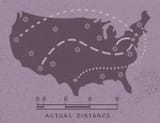
Best Uses of Laravel Vapor
As a Solutions Architect at Happy Cog, I often find myself in the weeds working with complex server architectural configurations in our clients’ AWS platforms. You may often find me setting up complex infrastructure by code with AWS Terraform, deploying fleets of EC2 instances powered by Continuous Integration pipelines, and working to curate complex load balancing solutions for our clients who receive unexpected bursts of views from our marketing campaigns (the list goes on).




